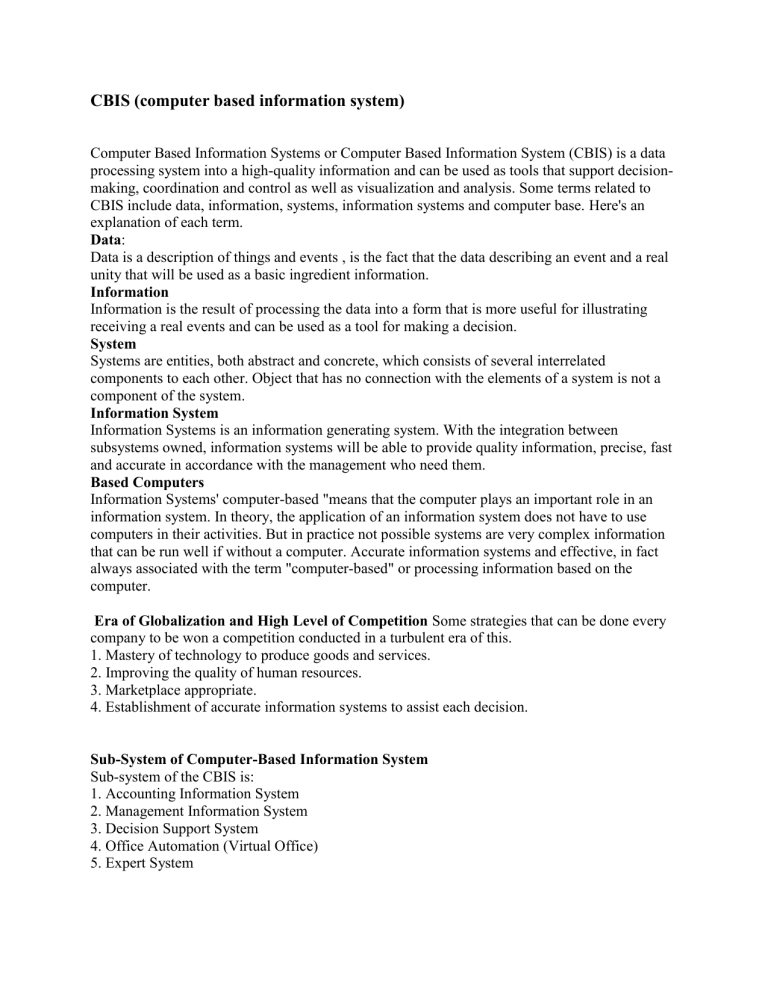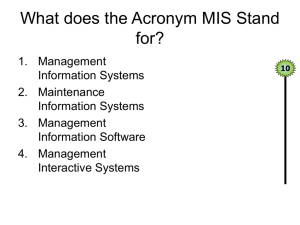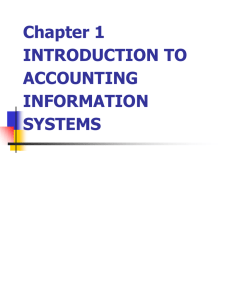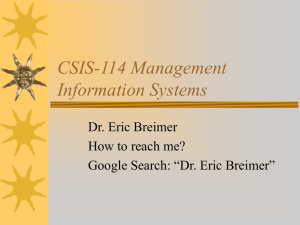
CBIS (computer based information system) Computer Based Information Systems or Computer Based Information System (CBIS) is a data processing system into a high-quality information and can be used as tools that support decisionmaking, coordination and control as well as visualization and analysis. Some terms related to CBIS include data, information, systems, information systems and computer base. Here's an explanation of each term. Data: Data is a description of things and events , is the fact that the data describing an event and a real unity that will be used as a basic ingredient information. Information Information is the result of processing the data into a form that is more useful for illustrating receiving a real events and can be used as a tool for making a decision. System Systems are entities, both abstract and concrete, which consists of several interrelated components to each other. Object that has no connection with the elements of a system is not a component of the system. Information System Information Systems is an information generating system. With the integration between subsystems owned, information systems will be able to provide quality information, precise, fast and accurate in accordance with the management who need them. Based Computers Information Systems' computer-based "means that the computer plays an important role in an information system. In theory, the application of an information system does not have to use computers in their activities. But in practice not possible systems are very complex information that can be run well if without a computer. Accurate information systems and effective, in fact always associated with the term "computer-based" or processing information based on the computer. Era of Globalization and High Level of Competition Some strategies that can be done every company to be won a competition conducted in a turbulent era of this. 1. Mastery of technology to produce goods and services. 2. Improving the quality of human resources. 3. Marketplace appropriate. 4. Establishment of accurate information systems to assist each decision. Sub-System of Computer-Based Information System Sub-system of the CBIS is: 1. Accounting Information System 2. Management Information System 3. Decision Support System 4. Office Automation (Virtual Office) 5. Expert System ACCOUNTING INFORMATION SYSTEMS (AIS) AIS is an information system that implements corporate accounting application, ie as data processing companies, the Company cannot choose to use the AIS or not, this system is a necessity. All companies basically implement procedures the same. AIS is more oriented to the data than the information, although there was some information generated. AIS provides a consistent database for other information. AIS is the only system responsible for the information needs of information outside the company, providing environmental information to all except the competition. The main task of this information system are: • Data collection • Manipulation of data • Data storage • Provide documents Data Collection Any action taken by the company that involve environmental elements such activities is called the transaction, the action described by a data record, the recording is known as transaction processing. Data processing system to collect data that describe each company's internal actions and transactions within the enterprise. Data Manipulation is the task of changing data into information. Data manipulation include: • Classification, identification and grouping data using the encoding of transaction records. • Sorting, preparation of a specific order based on the code or other data elements. • Calculating, arithmetic and logic operations are performed on the data elements. • Summarizing, the data so that the resulting inference total, average and others. Data Storage The data has been recorded and stored in secondary storage media, and logically integrated in the form of a database. Provision Document AIS produces the information to individuals or organizations both within and outside the company, which was triggered by two things, namely: • Actions, which is the output if anything happens. • Time, which is the output at a given moment. Characteristics AIS • Carry out the necessary tasks. • With a focus on a relatively standard procedure. • Dealing with detailed data. • Focusing on the historical. • Provide a minimum of troubleshooting information. Role AIS in CBIS • AIS produces some output information in the form of standard accounting reports. • AIS provides a comprehensive database for use in solving problems. MANAGEMENT INFORMATION SYSTEM (MIS) Based system is a computer database that provides information to several users with similar needs. Users typically form a formal entity below the company or subunits, MIS Resources Information explaining the company or one company's system of what has happened in the past, what is happening now, and what might happen in the future. This information is available in periodic reports, special reports, and results of mathematical simulation, the output information is used managers as they make decisions to solve the problem. All information has similar characteristics to the field of functional areas (marketing, manufacturing, tablespoons, and finance), management level (operational, managerial, and strategic), and the user (manager or non-manager) driver's license information to obtain data from the database, where database contains data and information from the SIA and the environment. A MIS can also be an inter-organizational information systems (IOS) if a MIS connected to the MIS on other companies such as the Supplier. MIS and AIS MIS using data provided by AIS in the database, and other information from the environment. The contents of the database is used by software to make periodic reports and special reports, as well as mathematical models to simulate aspects of company operations, contrast with the AIS, the MIS has no obligation to provide information on the environment. MIS & Enterprise IS MIS will be formed as a whole if all the organizations information systems have been formed and connected to each other. Data and information stored in the same database and can be used in other functional areas. MIS is the basis for the establishment of information systems more sophisticated and complex emerging in recent years, the Corporate Information System also known as Enterprise Information System (EntIS) DECISION SUPPORT SYSTEMS (Decision Support System) In an effort to solve a problem, solver will be a lot of decision making. Decisions must be taken to avoid or reduce negative impacts or to take advantage of opportunities. The decision divided into: • Decisions are programmed, and the routine is repeated. • Decisions are not programmed, is new and not structured, there is no certain method to handle because unprecedented. Managers do four stages of decision-making, namely: • Intelligence Activities, observing environmental conditions be improved. • Designing activities, discover, develop, and analyze a variety of alternative actions that may be. • Selecting activities, choose one among alternative courses of action. • Activity Review, assess the options and then. Type DSS The first type only allows managers to take a decision elements, such as asking how many sales region X. • The second type of special reports obtained from a file, such as inventory reports. • The third type allows the manager received a report from different files, such as the income statement. • The fourth type allows managers to see the effects of various decisions. For example changes in product prices and their implications for profits. • The fifth type allows managers to accept the proposed decision, for example, obtain the optimal price of a mathematical model. • The sixth type capable of providing a decision, such as computers that decide the amount of premium to customers under the age of 25, working in the Trans Am, etc. Stay in Houston. DSS first three simply by using a database query, while the last three must include a mathematical model. Destination DSS • Assist managers to make decisions for semi-structured problem-solving. • Support the assessment manager is not trying to replace it. • Improve the effectiveness of decision-making on efficiency manager. EXPERT SYSTEM (ES) Expert system (Expert System) is an information system that has artificial intelligence (Artificial Intelligent) that resembles human intelligence. Expert system similar to the DSS is aimed at providing support for high-level troubleshooting for users. Differences ES and ES DSS is the ability to explain the flow of his reasoning in reaching a specific solution. Very often explain how to solve the problem proved more valuable than the solution itself. Characteristics of Expert System • Have the ability to learn or understand the problem from experience. • Providing rapid response and satisfactory to the new situation. • Able to handle complex problems (semi-structured). • Solving problems by reasoning. • Using knowledge to problem. Expert System Part User Interface, is the part that allows managers instructions and information into and receive information from the expert system. 1. There are four methods of input that is • Menu • Commands • Natural Language • Customized Interfaces 2. Output Expert System, among others: • Explanation of the question • Explanation of solving problems 3. Knowledge Base, is a part that contains the facts that explain the problem areas, and also explains techniques that explain how the problem of those facts fit one another in a logical sequence. The term problem domain is used to describe the problem areas. 4. Interference Engine, is part of expert systems that perform reasoning using the knowledge base content based on a particular order. During the consultation, interference engine testing rules one by one and when the right conditions one action is taken. 5. Development Engine is a tool used to create expert systems, in this case the two devices are commonly used programming language and the ES shell. Expert System Examples • XSEL, an expert system that acts as an assistant sales agent sales on DEC computers, which helps customers choose the computer that meet their individual needs. • MYCIN, an expert system developed at Stanford University's 19,870 years with the aim of helping medical personnel in diagnosing diseases caused by bacteria. • Prospector, the system created Richard Duda, Peter Hard, and Rene Reboh in 1978 that provides the ability of a geologist. OFFICE Automation (OA) Office automation is now referred to as a virtual office, includes all the electronic systems of formal and informal communication is primarily concerned with information to and from the people within and outside the company. OA users are divided into four categories, namely: • Manager, is responsible for managing company resources. • Professional, but did not manage to contribute a special expertise that distinguishes them with secretaries and clerks. • Secretary, was assigned to assist skilled workers (Managers & Professional) for carrying out various tasks correspondence, answering the phone, and schedule meetings. • Employee Administration, perform the duties for the secretary, such as copiers documents, save documents, and send mail. Destination OA • Avoiding costs, the computer can not replace the current employees, but at least delay the addition of required to handle the additional workload, • Problem Solving groups, contribute to communication between managers • Complement, OA can not replace the traditional interpersonal communication such as face to face, telephone conversation, writing memos, and the like, but OA is complete so that when combined with traditional media will provide synergy. OA Applications • Word Processing • E-Mail • Voice Mail • Electronic Calendaring • Audio Conferencing • Video Conferencing • Computer Conferencing • Duplicate • Imaging • Desktop Publishing OFFICE Automation (OA) Office automation is now referred to as a virtual office, includes all the electronic systems of formal and informal communication is primarily concerned with information to and from the people within and outside the company. OA users are divided into four categories, namely: • Manager, is responsible for managing company resources. • Professional, but did not manage to contribute a special expertise that distinguishes them with secretaries and clerks. • Secretary, was assigned to assist skilled workers (Managers & Professional) for carrying out various tasks correspondence, answering the phone, and schedule meetings. • Employee Administration, perform the duties for the secretary, such as copiers documents, save documents, and send mail. Destination OA • Avoiding costs, the computer can not replace the current employees, but at least delay the addition of required to handle the additional workload, • Problem Solving groups, contribute to communication between managers • Complement, OA can not replace the traditional interpersonal communication such as face to face, telephone conversation, writing memos, and the like, but OA is complete so that when combined with traditional media will provide synergy. OA Applications • Word Processing • E-Mail • Voice Mail • Electronic Calendaring • Audio Conferencing • Video Conferencing • Computer Conferencing • Duplicate • Imaging • Desktop Publishing D. CBIS Contribution Current information system is the most important issues in management control. This is because the purpose of management control is to assist management in coordinating subunit-sub-unit of the organization and directs these parts to achieve company goals. Two things of interest from the definition above is coordinating and directing. Of course in these two processes requires a system for coordinating and directing the process can work effectively so that corporate goals can be achieved. The main benefits of the development of information systems for management control systems are: o saving time (time saving) o cost savings (cost saving) o improved effectiveness (effectiveness) o technology development (technology development) o accounting personnel development (accounting staff development). With a variety of benefits and contributions provided, it is expected of each company can survive in the arena of an increasingly tight competition.





